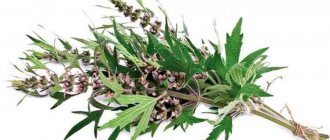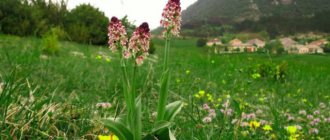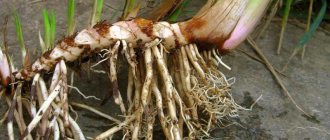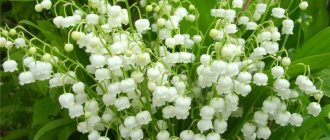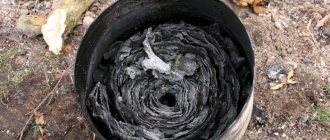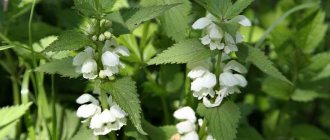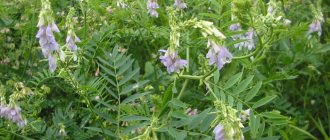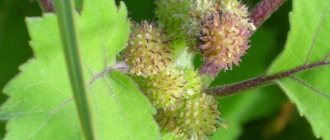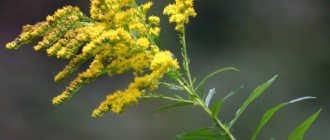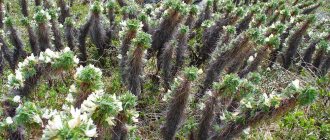Mountain arnica is a perennial from the Asteraceae family, sometimes called lamb grass, hare cabbage, or lamb grass. Latin name: Amica montana. In some regions, its numbers are steadily declining, so arnica is listed in the Red Book and is not harvested on an industrial scale. General pharmacognosy tells in detail about medicinal plants, their properties, methods of procurement, drying, storage, cultivation, as well as the use of prepared raw materials.
Botanical description
The plant has a tall (80 cm) erect round pubescent stem, on which paired elongated dark green leaves 15 cm long sit. Its top is decorated with 1 to 3 baskets. In the middle of each there are up to 50 tubes bordered by petals. Yellow daisies delight the eye until autumn. They are collected in baskets decorating the top of the head.
The fruits are cylindrical in shape with a tuft at the top, pubescent with thick hair, narrow at the base, of different colors: from yellow-green to dark gray. The rhizome is short, creeping, red-brown in color, has many adventitious branches, and lies close to the surface.
Photo of arnica in the wild
The flower loves alpine meadows and forests in the mountainous regions of western Ukraine, Belarus, the Baltic states, and Eastern Europe; it is rarely found on the plain . The plant is not picky and grows even in poor soils, cleared areas and fires, as well as in shade. It does not cover large areas; it grows in small groups or singly.
What it looks like and where it grows
Mountain arnica, or mountain ramwort (Arnica montana), is a herbaceous plant from the Asteraceae family. It has a creeping short rhizome of brown or red-brown color with many adventitious shoots; on the upper side of the main stem there are scars from previous stems.
Mountain arnica rises up to 80 cm above the ground
Arnica shoots are straight, sometimes branched towards the end, with short pubescence. The leaves are wide and oval or oblong at the root, lanceolate and pointed at the stem. From June to August, the plant bears flowers - yellow ligulate marginal flowers and orange or dark yellow middle, tubular. Basket buds are located at the tops of the shoots. From July to August, the fruits ripen - cylindrical achenes, pointed at both ends, greenish or dark gray in color with a pale yellow tuft.
Attention! In the first year of life, mountain arnica forms a basal rosette of 6-8 leaves, and only in the next season does the stem develop.
The grass grows in Europe, in the westernmost regions of Belarus and Ukraine, in Latvia and Lithuania. It chooses pine-birch and beech forests for life, found in meadows, forest edges and clearings, in the Alps up to 2800 m above sea level.
Chemical composition
Arnica is rich in various substances. Many of them are found in flowers.
The plant contains:
- arnicin;
- ascorbic malic, palmitic, lactic, formic, angeic, fumaric acids;
- essential oil;
- inulin;
- phytosterols;
- vitamin C;
- wax;
- resins;
- carotenoids;
- fat;
- gum;
- betaine;
- choline;
- carnaubyl alcohol;
- chlorophyll;
- cynarin;
- helenin;
- Sahara;
- zeaxanthin;
- tannins and sulfur-containing substances;
- slime.
Growing on site
Arnica loves fertile and moderately moist soil. For the non-chernozem zone, it is preferable to grow Chamisso or foliage arnica. These herbaceous plants are for open ground; slightly acidic or neutral soil is suitable for planting them, without stagnant moisture in the spring, which can cause arnica to become wet. Reproduction is carried out by seeds and dividing the bush. When planting seeds, they are sown in the ground in early spring, the planting depth is up to 1.5 cm, the width between rows is up to 60 cm. Under favorable conditions, seedlings appear in 15-20 days. Propagation by seeds can be carried out through seedlings, planting them in pots in a warm place 2-3 months before planting in the ground.
Planting with roots is carried out when the length of the shoots reaches at least 5 cm, they are planted at a distance of at least 30 cm. In the first year of life, the soil is watered, weeds are removed and often loosened. During the active growing season, feed with slurry diluted with water in a ratio of 1:10.
Beneficial features
The plant is used in folk medicine. It helps with injuries and stops bleeding, tones the uterus, and relieves inflammation. Depending on the dosage, it both calms the body and tones it. Arnica infused with alcohol has a choleretic effect.
Thanks to the arnicine present in the plant, the spinal cord and brain are stimulated, the heart rate is normalized, blood vessels are strengthened, and blood pressure is reduced. Preparations based on arnica treat enterobiasis, as they have an antiparasitic effect. They are also a powerful preventative against the development of tumors.
Medicinal properties of mountain arnica
Mountain arnica has a positive effect on the body and improves health. When consumed in moderation, the plant:
- stops bleeding;
- stimulates bile production;
- has a sedative effect and eliminates seizures;
- dilates blood vessels and lowers blood pressure;
- tones the nervous system;
- improves heart function and helps with angina pectoris;
- increases the contractility of the uterus in women;
- helps with cholelithiasis and cholecystitis;
- helps cure cysts, polyps and fibroids;
- improves liver and kidney function;
- has a mild analgesic effect.
The healing properties of arnica promote the resorption of hematomas. The plant is used externally for bruises, cuts, abrasions and ulcers. Mountain arnica helps normalize the menstrual cycle in women.
Application in medicine
People have long valued arnica for the variety of its medicinal properties. Basically, decoctions, tinctures, and extracts are made from it, which help with disorders of the gallbladder, cardiovascular system, and treat viral infections.
- With the help of a decoction of lamb, inflammation in the oral cavity is relieved. This procedure also improves blood supply to the mucous membrane, which increases its resistance to various infections. In addition, the herbal decoction is used externally to treat skin ulcers, rashes, and boils. Homeopaths also use ointments based on it, which help with sprains and bruises, and inflammation of the joints. To relieve muscle pain, massage with arnica oil is used.
- Cosmetologists use a decoction to moisturize dry skin and eliminate spider veins, as well as get rid of dark circles under the eyes.
- Lamb is an excellent way to quit smoking, since regular use of its tincture causes an aversion to tobacco.
- Alcohol producers add the plant's flowers to their products as a flavoring agent.
Arnica in cosmetology
Women spend a lot of time on their appearance. It is this plant material that will help normalize not only the condition of the skin, but also the hair. After all, having gorgeous hair always attracts the attention of others. To obtain a positive result, you can use almost all dosage forms based on this plant.
INTERESTING fact: Cyst in the nose: symptoms and treatment without surgery
Extract
It is not recommended to apply it in its pure form, as it can cause negative consequences. The ratio of application of the amount of the drug depends on the percentage. Most often it is simply added to shampoos, conditioners and other cosmetics.
Tincture
It helps to bring airiness and lightness to the hair and eliminate the stratum corneum. For it you need:
- 10 g inflorescences;
- 100 ml alcohol.
Place everything in a dark glass container and leave for 8 days. From time to time the contents need to be shaken. After the allotted hour, it is diluted with water in a ratio of 1 to 4 and rubbed into the scalp. It is recommended to do this at night. In the morning, just wash your hair.
You can also moisten a cotton swab with it and cauterize the herpes. Taking a few drops internally daily will help suppress the manifestations of this disease.
Mask to stimulate hair growth
You will need:
- 10 ml of tincture of this plant;
- 2 tbsp. l. curdled milk;
- 30 g natural honey;
- 1 yolk;
- 40 g burdock oil.
Combine everything and warm it up a little. First, rub into the roots and then cover the strands. Wrap your head in a towel for 30 minutes. Afterwards, wash everything off. Then you can rinse with chamomile decoction.
For excessively oily scalp
To eliminate this unpleasant manifestation you need to mix:
- 10 ml of infusion;
- tsp mustard powder;
- 2 tbsp. l. blue clay;
- the same amount of apple cider vinegar.
Treat each strand separately and the skin. Make a warm cap and wear it for 25 minutes. Afterwards, wash everything off.
Anti-wrinkle mask
Using it will eliminate some aesthetic troubles. Creams based on it are considered simply magical, capable of working miracles. It is not difficult to prepare this option at home. To do this you need:
- 2 tbsp. l. grated cucumber;
- per tsp. olive oil and arnica infusion.
Mix everything thoroughly and apply on your face for 10 minutes. Rinse with warm water and wash with cool water. Quite often, oily skin is accompanied by clogged pores. This product will help cope with excess fat deposits and acne.
Recipes
Heart
For the treatment of hypertension, angina pectoris, myocarditis, recovery after a heart attack, stroke, and normalization of heart rate, the tincture is used. To prepare it you will need: medical alcohol - 200 ml, mountain arnica flowers - 70 g. The dried parts are crushed, placed in a glass container, and filled with alcohol. Then leave in a cool, dark place for 15 days. After this period, filter. A teaspoon of the product is dissolved in 50 ml of water and taken before meals for one month.
Gynecology
Arnica is widely used to treat the female genital area, as it has a pronounced anti-inflammatory effect. To do this, use an infusion for douching.
The herbal mixture intended for these purposes includes:
- mountain arnica flowers (20 g);
- chamomile (20 g), calendula (20 g);
- plantain leaves (15 g);
- peppermint (15g);
- water (500 ml).
The dried parts are crushed, poured with boiling water, left for two hours, cooled and filtered. A warm solution is drawn into a syringe and irrigated the vaginal walls. Or soak a gauze swab in the infusion and insert it into it for 1.5-2 hours. Thus, inflammation is relieved and blood supply to the genitals is improved, which, in turn, strengthens the resistance of the vaginal mucosa.
Skin problems
Arnica is often used in cosmetics. It is added to lotions, creams, milk, so it has the ability to regulate skin oiliness and fight acne. Thanks to the presence of lamb in the cream, the complexion is refreshed, the skin is tightened and toned, and dark spots disappear. At home, they make do with lotions and compresses from the infusion of this plant. It's easy to prepare.
Combine a glass of water and 10 g of arnica flowers, ground by hand, pour boiling water, leave for 1 hour, filter. The liquid is squeezed out, and the plant grounds are wrapped in a gauze napkin. The lotion is distributed under the eyes for 20 minutes. During this time, signs of fatigue will disappear and the skin will tighten. Regular procedures eliminate bags and dark circles on the face.
A water infusion of flowers is used for rubbing, washing, poultices, for ulcers, furunculosis, skin rashes, hematomas, bruises, frostbite, small wounds, burns, gout, rheumatism, lumbago, and for gargling.
To get rid of these misfortunes, take 3 teaspoons of dried baskets, combine with 2 cups of boiling water, leave for 2 hours. Apply arbitrarily (the more often, the better).
Hemostatic
A decoction of the plant is used to stop bleeding. Combine 250 ml of water and 15 g of flowers, pour boiling water and keep in a bath for 20 minutes. Remove from heat and leave for an hour, then filter and add hot water, increasing the total amount of liquid to 250 ml. Take orally after meals 3-4 times a day, adding a tablespoon of decoction to 50 ml of milk.
As a result of regular use of the drug, blood clotting increases, which helps stop any bleeding.
Hepatitis, cholecystitis, cholelithiasis
Pour 3 tablespoons of flowers into a glass of boiling water, keep in a water bath for 10-15 minutes, then leave for about an hour, filter. Take 15 ml after meals 3 times a day with milk.
Stomach, bloody diarrhea, epilepsy, bronchitis, flu, gout, seizures
Place 2 teaspoons of flowers in 250 ml of water, keep in a bathhouse for 15 minutes from the moment of boiling, allow to cool naturally, filter. Take 1-2 tablespoons three times a day, diluted with milk or water.
Myocardial dystrophy
Take 20 g of montane arnica and black elderberry flowers, 30 g of rosemary leaves, chop and mix. Combine 300 g of boiling water and 3 g of the mixture, steam for an hour, filter. Take 15 ml 3 times a day.
Stomatitis, pharyngitis, sore throat, periodontal disease
Three teaspoons of flowers are poured into two glasses of boiling water, left for 2 hours, and filtered. The throat and mouth are rinsed 5 times a day.
Periodontal disease
Mix tinctures of arnica, calendula, eucalyptus (10 g each) in equal proportions, add 100 g of peach oil. The mixture is used for irrigation of gums and applications of periodontal pockets.
Lung tumor
The roots of mountain arnica and celandine grass are mixed in equal parts (50 g each) and crushed. Pour a tablespoon of the mixture into a thermos, pour 0.5 liters of boiling water into it and leave for 8-10 hours, then filter. Take 2/3 cup three times a day 30 minutes before meals. At the same time, drink 1 teaspoon of polylift oil 3 times.
Indications for use
Arnica montana tincture has proven itself well in the treatment of hypertension, cardiosclerosis, myocarditis and angina pectoris . The infusion has a good analgesic, anti-inflammatory, wound healing and hemostatic effect.
In obstetrics and gynecology, an alcoholic infusion of arnica is used as a hemostatic drug . It helps well with debilitating menstruation and bleeding caused by inflammation of the pelvic organs. The use of infusion in the postpartum period, aggravated by insufficient contractile function of the uterus, is also indicated.
Arnica is used for bruises and bruises, hematomas and swelling . The active components help accelerate peripheral blood circulation, as a result of which the resorption of hematomas occurs much faster. Experts recommend applying bandages and compresses with an aqueous infusion of the plant to the affected areas. For burns and frostbite of the skin, treatment with external dressings with arnica is also indicated. The mild analgesic effect of the infusion promotes rapid recovery.
Collection and procurement rules
Two-year-old arnica flower baskets are used as medicinal raw materials, as this is the most valuable part. In June-July, choose dry, sunny weather, and carefully cut off the inflorescences at the very base. Drying takes place in the fresh air in the shade, under a canopy or in a dark, well-ventilated room. Alternatively, you can use an oven or electric dryer, but the temperature should not exceed 60 degrees C. This gets rid of the insects and their larvae that are sometimes found there.
The inflorescences should not be stirred to avoid damaging the fragile baskets. It is recommended to store dried herbs indoors in linen bags or closed glass jars for 2 years.
In some cases, it is advisable to use arnica root. To harvest, it is carefully removed from the soil, thoroughly cleaned of soil and small branches, and washed in running water. Then cut into small pieces. The prepared roots are dried in any known way in the shade for 10 days, after which they acquire an original aroma. But there is a significant disadvantage here. The root collection procedure negatively affects plant reproduction.
For those who do not trust traditional recipes, the pharmaceutical industry produces a homeopathic external remedy - Arnica-GF in the form of an ointment or oil for rubbing. The attached instructions describe in detail how to use the medicine without harm to yourself.
Indications and contraindications
Experts recommend using the plant for the following ailments:
- Bleeding.
- Muscle pain.
- Cold.
- Bronchitis.
- Gastrointestinal diseases.
- Abrasions.
- Scratches, wounds.
- Inflammation of the mouth and throat.
The plant does not cause harm, but the recommended dosage must be followed, otherwise complications will arise. There are contraindications:
- Individual intolerance.
- Increased blood clotting.
- Children.
- Pregnancy.
- Lactation.
The drug is sold in the pharmacy in the form of solutions and essential oils. You can prepare tinctures, decoctions and tea from this plant at home. However, it is important to follow the dosage and instructions indicated in the recipe.
